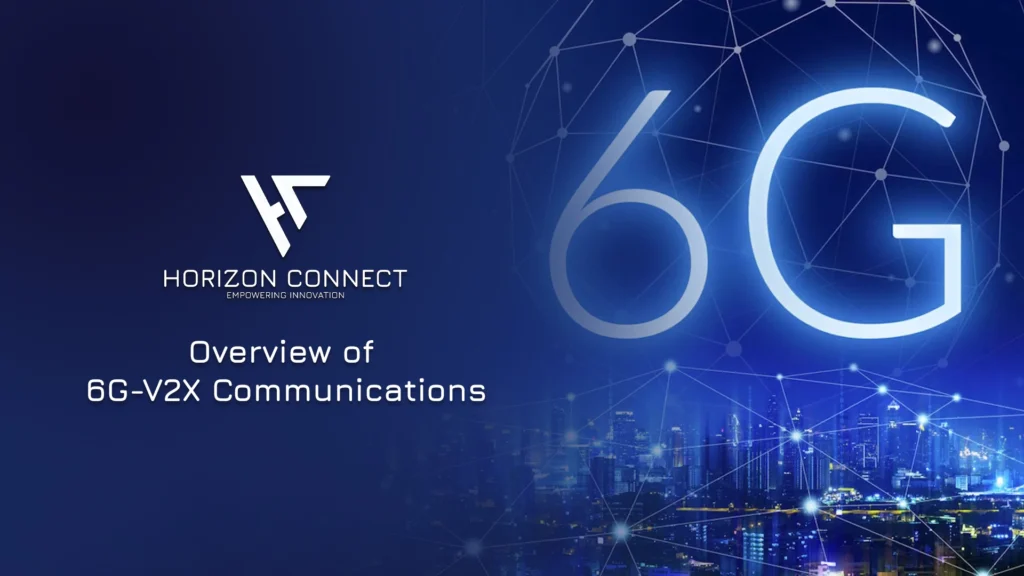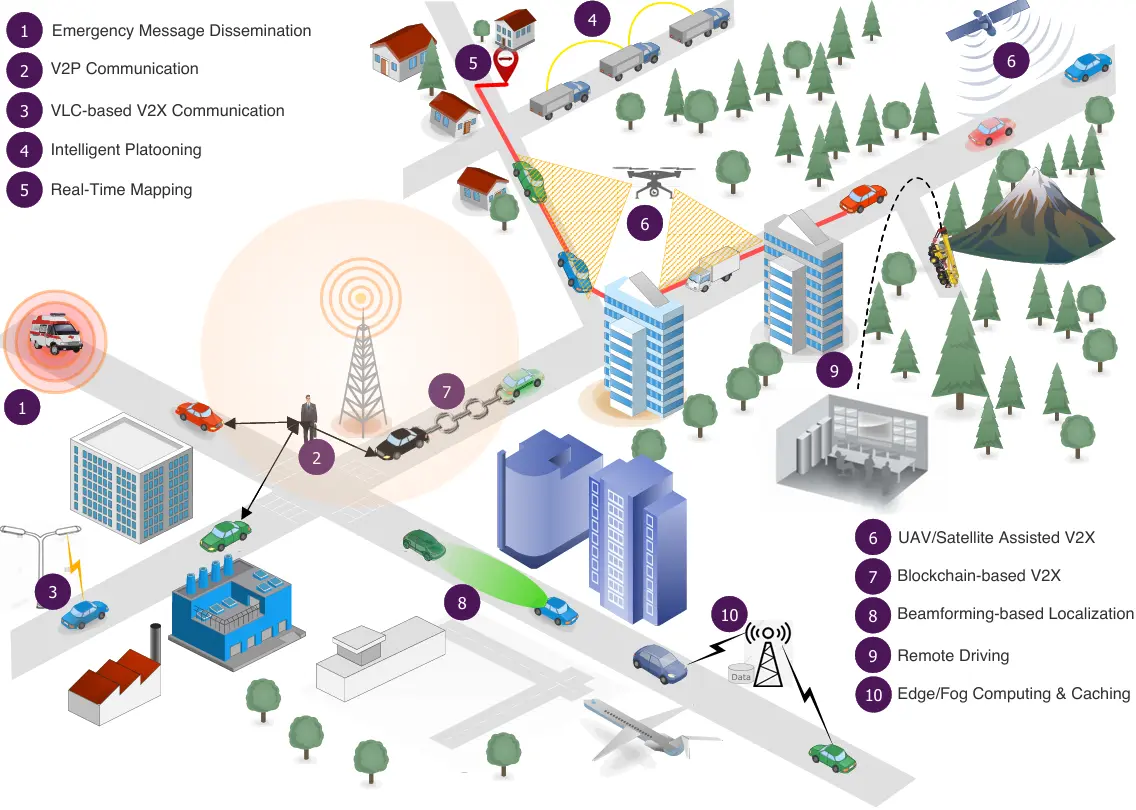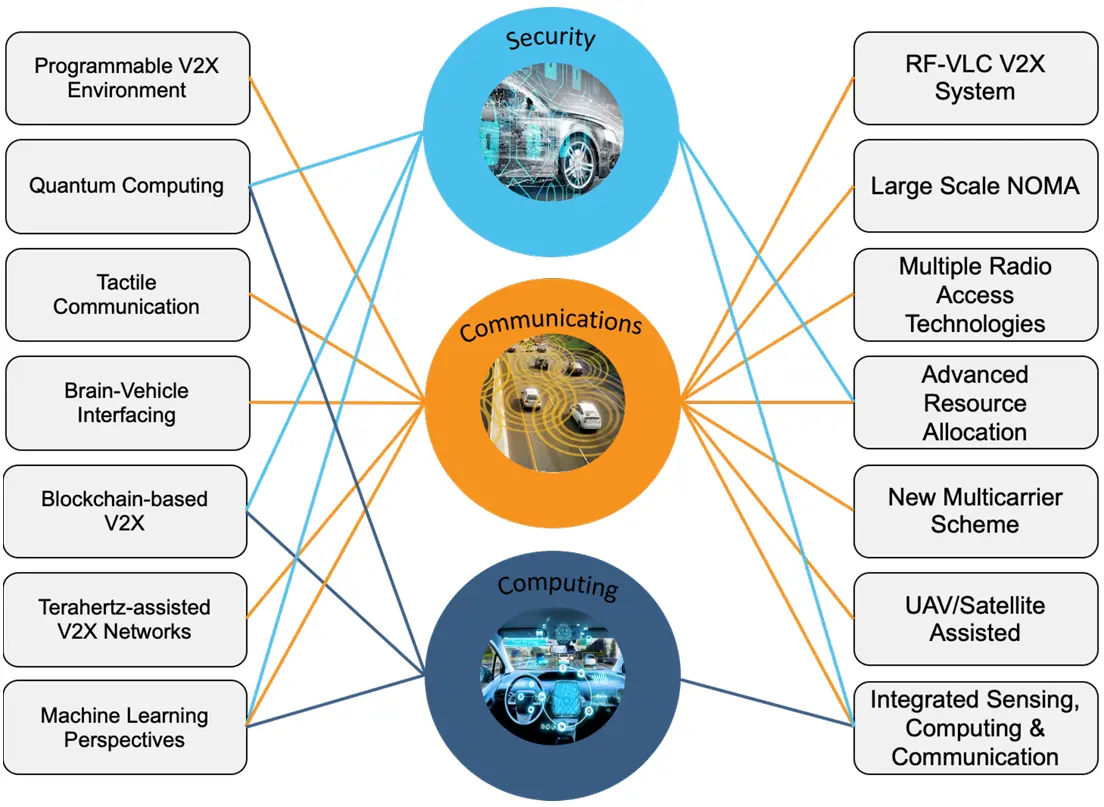The emergence of 6G-V2X communications is set to revolutionize the future of connected mobility. As autonomous vehicles and smart transportation systems become increasingly prevalent, 6G-V2X offers ultra-high data rates, low latency, and intelligent decision-making capabilities. This next-generation communication framework is designed to address the growing demands of Vehicle-to-Everything (V2X) interactions, enabling seamless connectivity between vehicles, infrastructure, pedestrians, and networks.

Why 6G-V2X?
While 5G-NR V2X has significantly enhanced performance with advanced services, its improvements rely on increased investments in spectral and hardware resources while maintaining the foundational mechanisms of LTE-based V2X. However, the rapid rise of autonomous vehicles, fueled by urbanization, higher living standards, and technological advancements, is driving a surge in communication devices and digital applications for intelligent vehicles.
Emerging demands for services like 3D displays, holographic control systems, immersive entertainment, and enhanced in-car infotainment are creating new challenges for V2X networks. These innovations are pushing the capacity limits of existing wireless technologies, presenting hurdles in terms of data rates, latency, coverage, energy efficiency, and security.
5G-based V2X systems may fall short in addressing the complex requirements and diverse use cases of next-generation transportation. Legacy V2X communication systems, despite their progress, provide only limited intelligence. To overcome these limitations, a paradigm shift is needed toward a more versatile and diversified network approach.
The introduction of 6G wireless communication networks aims to address these challenges by combining terrestrial networks with non-terrestrial platforms like satellites and unmanned aerial vehicles (UAVs). This integration will enable intelligent, ubiquitous V2X systems characterized by:
- Extreme Reliability and Security
- Ultra-High Data Rates (up to terabits per second)
- Sub-millisecond latency with billions of connected devices
- Energy-Efficient and Smart 3D Communication Coverage
Additionally, 6G is designed to incorporate machine learning (ML) to evolve V2X systems into intelligent and autonomous networks. This includes features like enhanced context awareness, self-aggregation, adaptive coordination, and self-configuration, setting the stage for a smarter and greener future of vehicular communication.

Key 6G-V2X Technologies
The ambitious vision of 6G-V2X communications relies on integrating disruptive technologies that revolutionize vehicular communication systems. These advancements will provide ultra-high data rates, enhanced energy efficiency, and greater security, paving the way for intelligent and autonomous transportation.
To achieve this, 6G-V2X technologies are categorized into two types: revolutionary technologies and evolutionary technologies. Revolutionary innovations such as Intelligent Reflective Surfaces (IRS), advanced machine learning (ML), and brain-vehicle interfacing bring a paradigm shift in how V2X systems interact. Meanwhile, evolutionary technologies build upon existing systems, enhancing capabilities in areas like multi-carrier schemes, resource allocation, and data security.

Revolutionary Technologies in 6G-V2X
The revolutionary technologies driving 6G-V2X communications aim to transform the transportation ecosystem with intelligent, adaptive, and high-performance solutions. These innovations redefine how vehicles interact with their environment, infrastructure, and users.
- Programmable V2X Environment
Programmable environments enhance flexibility and adaptability in communication, enabling vehicles to adjust dynamically to network conditions. - Tactile Communication
Offers a multisensory experience by exchanging haptic and sensory feedback, improving user engagement and enhancing autonomous vehicle control. - Quantum Computing
Delivers superior computational capabilities, optimizing data processing for real-time decision-making while ensuring advanced security. - Brain-Vehicle Interfacing
Enables seamless interaction between drivers and vehicles using neural signals, creating augmented control and immersive driving experiences. - Blockchain
Enhances data security and transparency in V2X networks, ensuring secure and decentralized communication for vehicles and infrastructure. - Terahertz (THz) Communications
Facilitates ultra-high-speed data transfer, essential for applications like 3D mapping, LiDAR, and immersive in-car infotainment. - ML-Aided V2X Design
Machine learning algorithms optimize communication systems by enhancing context awareness, predictive analytics, and adaptive decision-making.
These technologies collectively push the boundaries of what’s possible in V2X communications, shaping the future of autonomous and connected vehicles.
Evolutionary Technologies in 6G-V2X
Evolutionary technologies in 6G-V2X build upon existing systems, enhancing their efficiency, reliability, and scalability to meet the growing demands of next-generation transportation networks. These advancements are critical for creating smarter, more robust V2X communication frameworks.
- Hybrid RF-VLC V2X
Combines radio frequency (RF) and visible light communication (VLC) to improve data transfer rates, reliability, and energy efficiency. - Multiple Radio Access Technologies
Integrates diverse radio access technologies for seamless connectivity, reducing latency and improving communication reliability. - Non-Orthogonal Multiple Access (NOMA)
Supports massive connectivity and low-latency communication, crucial for applications like tactile internet and autonomous vehicles. - New Multicarrier Scheme
Enhances spectral efficiency and adaptability, allowing reliable and efficient data transfer under varying network conditions. - Advanced Resource Allocation
Optimizes network resources to handle high data traffic and ensure consistent communication quality across diverse use cases. - Integrated Sensing, Localization, and Communications
Provides centimeter-level accuracy in positioning and velocity estimation, essential for autonomous driving and intelligent traffic systems. - Satellite/UAV Aided V2X
Expands coverage to remote and hard-to-reach areas, ensuring uninterrupted connectivity in all terrains and environments. - Integrated Computing
Combines cloud, edge, and fog computing to deliver faster processing, optimized decision-making, and energy efficiency. - Integrated Control and Communications
Unifies control and communication frameworks to improve synchronization between vehicles, infrastructure, and networks, enhancing overall system performance.
These technologies refine and expand the capabilities of V2X communication systems, making them more resilient, scalable, and adaptable to the needs of future mobility.
Conclusion
The development of 6G-V2X communications is a transformative step toward creating smarter, safer, and more efficient mobility systems. From enabling autonomous vehicles to revolutionizing traffic management, 6G technology addresses the complexities of modern transportation.
At Horizon Connect, we are dedicated to advancing 6G-enabled solutions, ensuring a connected future that meets the evolving demands of the automotive connectivity industry.
This article was inspired by “6G for Vehicle-to-Everything (V2X) Communications: Enabling Technologies, Challenges, and Opportunities” Md. Noor-A-Rahim, Zilong Liu, Haeyoung Lee, M. Omar Khyam, Jianhua He, Dirk Pesch, Klaus Moessner, Walid Saad, H. Vincent Poor


